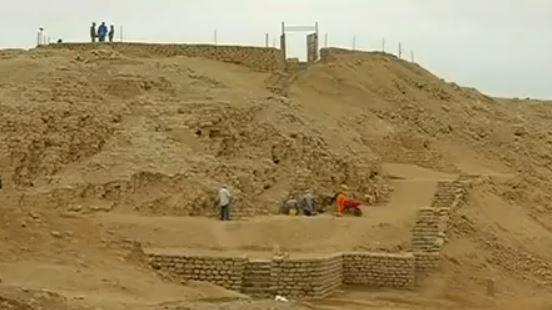
Antiquity officials in Peru have made a big announcement about a groundbreaking discovery in the South American country. An ancient tomb filled with treasures was disovered in Peru. Specifically, the tomb had gold treasures, three queens and the servants from 1,2000 years ago.
The tomb discovered in Peru is a pyramid mausoleum--called El Castillo de Huarmey (the Castle on the River Huarmey)--and is located in southern Peru. The research team (funded by the National Geographic Society) has dubbed the pyramid mausoleum with the name the "Temple of the Dead."
RELATED: Amelia Earhart Lived On Deserted Isle Of Nikumaroro In Her Final Days, New Photographs Suggest [VIDEO]
In the tomb discovered in Peru, the researchers uncovered a burial chamber after removing 30 tons of gravel from a passageway. The mausoleum was excavated secretly for months to keep the site away from looters. The tomb housed 1,200 artifacts such as gold earrings, silver and copper jewelry, bronze axes and silver bowls.
Additionally, the tomb discovered in Peru had small burial chambers for the three women rulers and 53 other women were buried in rows. It is believed that roughly half a dozen of the bodies found in the tomb discovered in Peru were human sacrifices for the queen.
RELATED: Spinning Statue: Watch 4,000-Year-Old Egyptian Relic Mysteriously Move On Its Own At Manchester Museum [VIDEO]
"So what were these first ladies doing at the imperial court? They were weaving cloth with gold instruments," says Krzysztof Makowski Hanula, an archaeologist at the Pontifical Catholic University of Peru in Lima and the project's scientific adviser.
The discovery, made by a team led by Milosz Giersz of Poland's University of Warsaw, is a unique finding since it is rare to find an unlooted tomb.
"I was really very, very surprised to find the site unlooted," Giersz said to USA Today about the tomb discovered in Peru.
RELATED: Ancient Mayan City 'Chactun' Found In Campeche, Mexico From Late Classic Mayan Period [PHOTOS & VIDEO]
"The Wari lords have long been overshadowed by the later Inca, whose achievements were extensively documented by their Spanish conquerors," says the National Geographic. "But in the 8th and 9th centuries A.D., the Wari built an empire that spanned much of present-day Peru. Their Andean capital, Huari, became one of the world's great cities. At its zenith, Huari boasted a population conservatively estimated at about 40,000 people. Paris, by comparison, had just 25,000 residents at the time."
© 2025 Latin Times. All rights reserved. Do not reproduce without permission.





